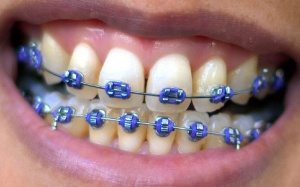Not all of us were born with beautiful, straight smiles that attract attention for the right reasons. Crooked teeth can leave many people feeling insecure in social situations. That said, modern advancements now allow people to attain the smile of their dreams quicker than ever before. Unfortunately, many people fail to properly care for their teeth while they’re wearing braces.
The Risks
Improper dental hygiene can be especially troublesome for people with braces. Since they can obstruct access to certain areas of the mouth, traditional metallic braces can promote plaque build-up. When this occurs, cavities and gum disease become more likely. This can compromise the cosmetic straightening process and put teeth at risk down the road, when the braces come off. To reduce the risk of problems, it’s important for patients to employ proper cleaning strategies and techniques.
Traditional Braces
Metal braces can interfere with brushing and flossing. To combat this problem, patients should use special stiff, angular toothbrushes that will fit in and around brackets and wires. To the chagrin of many, it’s important to brush after every meal, since food tends to collect around metal braces. Flossing is also critical to preventing plaque buildup; however, many people who have braces fail to do it enough, because it can be somewhat frustrating and tedious working around their braces. Visual inspection is also an important part of the process. Because they have rough edges, braces can snag and hold food particles; this can promote cavities and gum disease if left unattended.
Invisible Braces
Clear or “invisible” braces are far different from traditional braces, because they are removable. This makes them much easier to care for; after all, with the clear braces out of the mouth, a patient can brush and floss normally without having to worry about any sort of obstruction. With that being said, people with clear braces must brush more frequently. Since their teeth are covered by the removable braces most of the time, they aren’t exposed to air which helps reduce bacteria growth. Because they are more attractive and easier to care for, removable braces are becoming more popular with people who want to straighten their teeth discretely; however, they aren’t necessarily appropriate for patients who need significant improvement.
Playing it Smart
Unfortunately, although people spend thousands of dollars on braces, many often fail to protect their investment through proper oral care. According to Dr. Ken Collins, who provides both metal and clear braces at his Spokane office, he works hard to help patients understand the risks associated with lackadaisical brushing and flossing.
“Our team emphasizes to patients that, no matter what kind of braces you get, keeping the teeth clean during the straightening process is critical,” he said. “You don’t want to let plaque buildup that can lead to cavities or have trouble with gum disease, because it can endanger the teeth that we’re working so hard to straighten.”
Whether they choose traditional metal or removable braces, patients are making a big investment in their mouths. By simply practicing consistent, good oral hygiene, they can help ensure that they get the results they expect; so they can enjoy the confidence and improved self-esteem that comes with straighter smiles.
Featured images:
- License: Creative Commons image source
Ryan Lawrence writes for Off-Topic Media. OTM thanks Dr. Ken Collins for his contributions to this story. Dr. Collins can be reached at Collins Dentistry & Aesthetics in Spokane, Washington.





